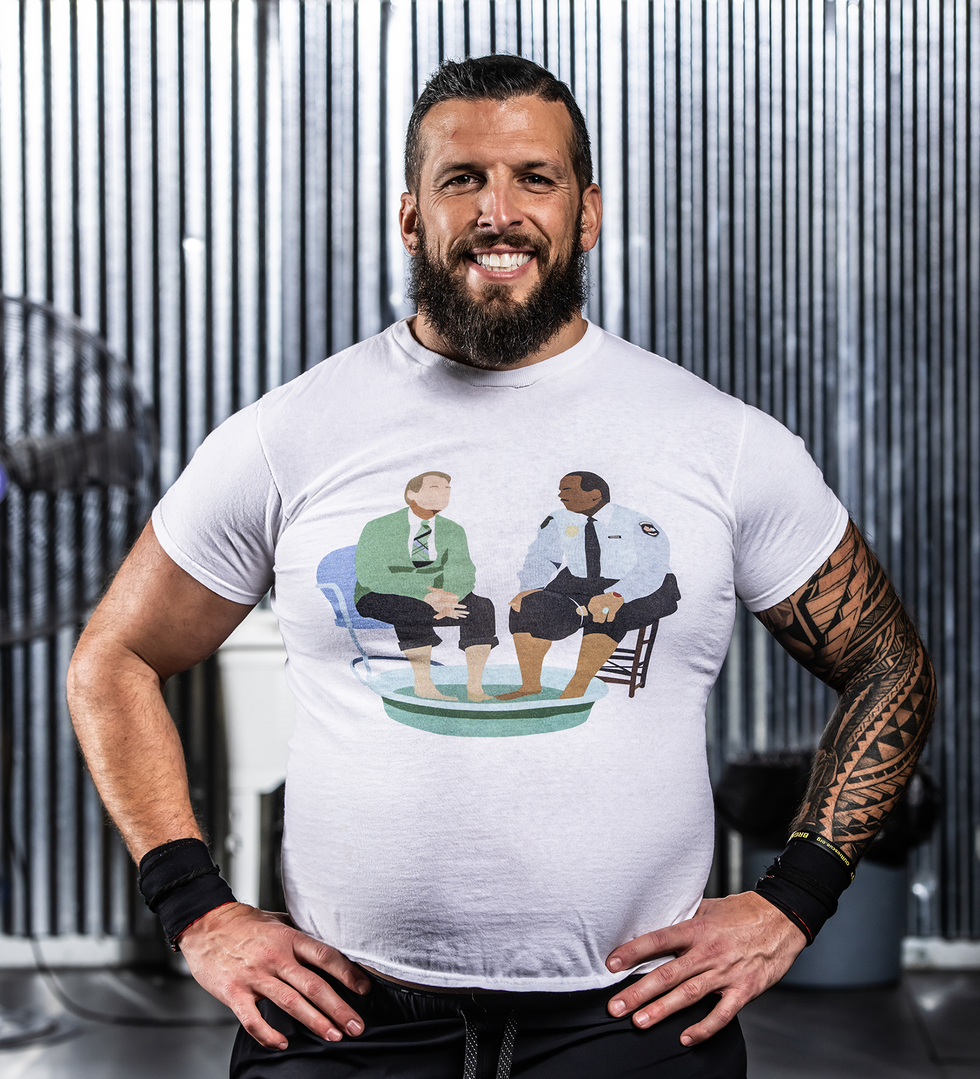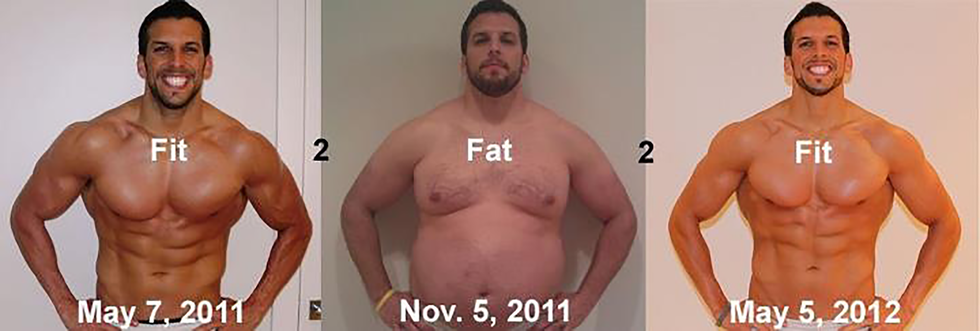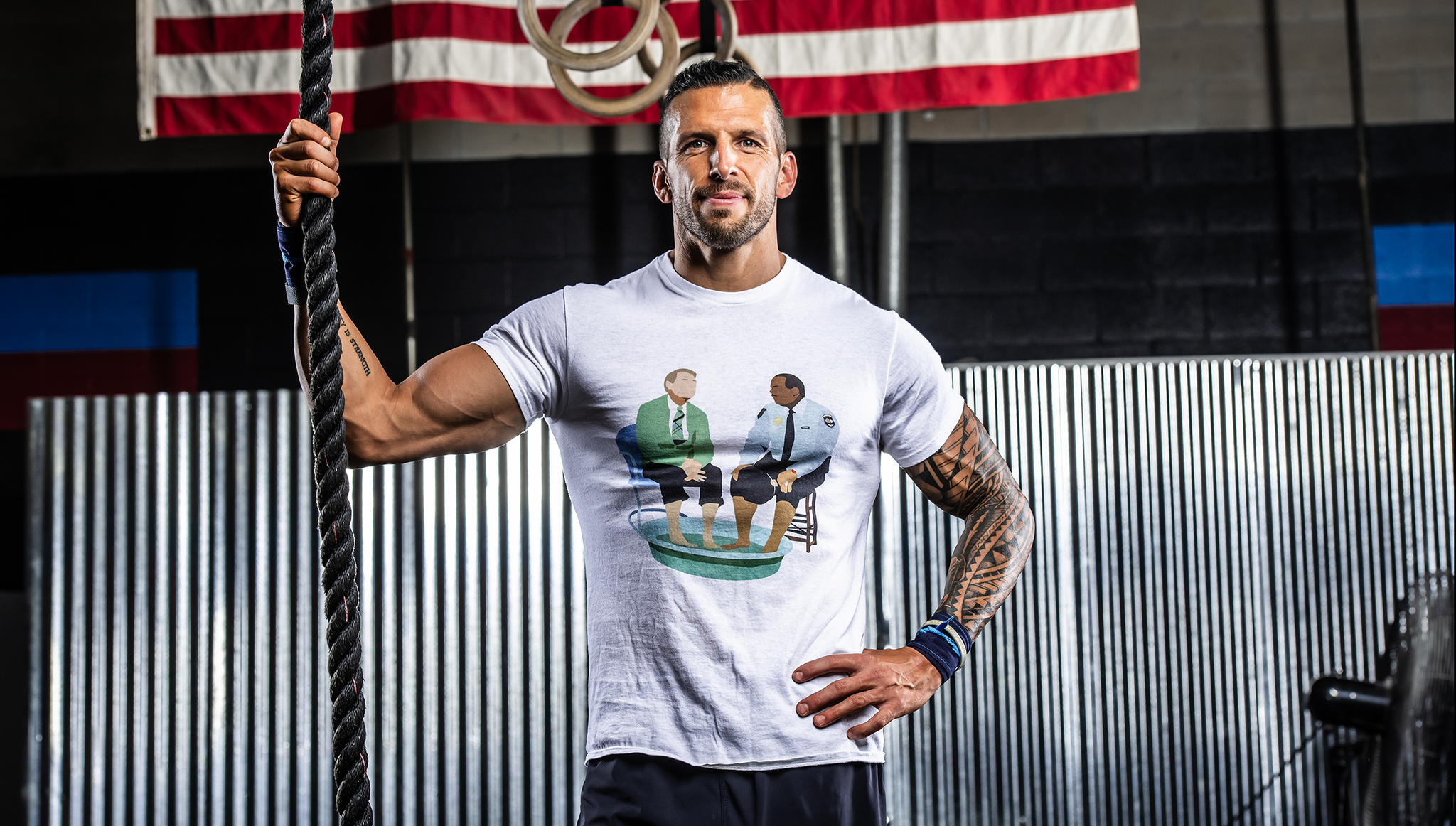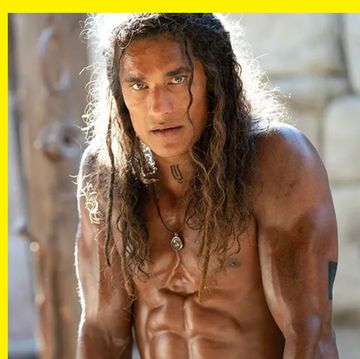IN LATE OCTOBER 2020, Drew Manning, a 39-year-old NASM-certified personal trainer turned fitfluencer best known for his unique brand of weight-loss challenges, stood in front of a camera inside his kitchen in Salt Lake City. In front of him, there was a large pile of Halloween candy set out on the center island.
“Are you guys ready for this?” Manning asked nervously before rolling up his black t-shirt to reveal an ample stomach, and stopping just short of what he’d taken to calling his man boobs. “I need some breathing room for my belly,” he told the camera. Then Manning slapped it a few times with an audible smack-smack-smack and reached for some Almond Joys.
The challenge was simple: Over the next 15 minutes, Manning would try to eat as much of the pile as he possibly could, binging on all things chocolate and/or loaded with added sugar.
When he posted the ensuing video on his Fit2Fat2Fit YouTube several days later, he promoted it to the million-plus followers he has across Instagram, YouTube, and Facebook. The stunt joined several other extreme eating sessions. Each episode lasts about 12 minutes with close-up shots of whatever he’s gorging from pancakes, to steak and potatoes, to everything he can find at a theme park (including funnel cake, a burger, fries, German chocolate cake, pavlova, cotton candy, beer, and a peanut butter rice crispy treat).
After each stunt, though, Manning felt like trash. “You literally can’t do anything for the next six to eight hours,” he tells Men’s Health. ”So, we always had to schedule [these shoots] towards the end of the day so that I could just lay down. I kind of hated doing these because I knew they were for entertainment. They would get a good amount of views but at the same time it’s just like a day of your life wasted.”
For the Halloween video, he’d added some variety by comparing his efforts against those of his girlfriend, Julie, who documented the same thing separately. But all of the stunts were part of a larger, more absurd and potentially even irreversible goal: to gain 60 pounds in four months, and then try to lose it all in another four. Having started seven weeks earlier, Manning was scheduled to hit peak weight just in time for his 40th birthday in late December, kicking off what he called his Back2Fit challenge, which anyone could join for the New Year.
To accomplish the radical weight gain, Manning had to go big, doubling his daily caloric intake and ceasing to exercise completely. By the day of the Halloween challenge, the 6’1” former collegiate football player weighed 222 pounds, up about 40 from two months earlier, though that wasn’t immediately obvious until he showed his belly. The lifelong athlete and weightlifter's bearded face was still thin and his shoulders were much broader than his hips. His biceps were large, and on the one forearm that wasn’t covered in tattoos, the muscles were well-defined.
After a pound or so of candy, Manning hit the wall with a king-size bag of Skittles, which he chewed into a giant wad and spent a minute coaxing down his throat. A few times, he put his hand up to his mouth like he was about to be sick, which was his one red line for these challenges. Finally, about five minutes later, Manning raised his last Twix to signal he was out. Julie ended up eating more than him, although, she, too, ended up leaning against the counter and sweating during the attempt.
Then, as if on cue, the duo shared a teachable moment: “I wanted her to feel my pain and to experience what I experience,” he says later in the video. “Well, I do,” Julie says while holding his hand. “I have empathy.”
FOR THOSE UNFAMILIAR with Manning’s emotion-first brand of life coaching, empathy is perhaps the most important selling point. He has spent nearly a decade finding ways to signal that he understands the experience of wanting to lose weight and is therefore able to connect with and help people in the same situation.
Manning rose to fame in 2011 when, after claiming that he couldn't relate to his clients’ supposed lack of willpower, he launched his original Fit2Fat2Fit challenge on YouTube, intentionally gaining and then losing 75 pounds. That attempt went viral, and he appeared on CNN and Good Morning America and wrote a New York Times bestseller about his experience. Then the A&E network gave his story the reality TV treatment by pushing other trainers to replicate the challenge.
Unlike many fitfluencers whose self-discipline and muscular physique seem to be a part of their wide appeal (see Athlean-X’s Jeff Cavaliere or Bobby Maximus), Manning’s fame is tied to first making some obviously unhealthy choices, and then trying to undo them. “This definitely exhibits binge-like behavior,” says Dr. Fatima Cody Stanford, M.D., an obesity medicine physician at Harvard Medical School, about his recent stunts.
Along the way, Manning has built a million-dollar health empire by selling products that promote a Keto diet, along with his own line of supplements, workout apps, and online coaching training. He says his programs have helped more than 500,000 clients, and he has more than 51,000 YouTube subscribers, 264,000 followers on Instagram, and a million followers on Facebook, where he shares “Empathy First” imagery and sports #TeamEmpathy t-shirts. “No one cares how much you know until they know how much you care,” Manning says often.
He doesn’t believe that gaining and losing so much weight so quickly can permanently impact his body. “What I’ve been told from my doctors is your body is pretty resilient. It can handle abuse,” he says. “If you treat it right consistently with a healthy lifestyle, it can reverse a lot of the damage.”
Dr. Stanford disagrees with that assessment. This kind of rapid weight cycling “actually interferes with the signals between the brain and gut, particularly in the hypothalamus, which is the part of the brain that regulates weight,” she says. For Manning and anyone else who yo-yo diets that may make losing weight progressively more difficult.
But his latest challenge held one more big risk. The science has become increasingly clear that dramatic weight loss journeys similar to Manning's are neither practical nor sustainable for most people, and that how much you exercise may be a better predictor of your health than your body size. A growing movement no longer sees "fit" and "fat" as mutually exclusive. Would Manning's brand of performative empathy continue to age well?
MANNING WAS BORN to evangelize. He grew up in a strict Mormon household where everyone would wake up at 5 a.m. to read scripture, leaving him exhausted for wrestling or football practice. While he excelled at sports, eventually going on to play inside linebacker at Southern Virginia University, he says his parents were always unimpressed. “I never felt worthy or good enough no matter what I did,” he says.
At age 19, Manning deferred his enrollment at SVU to join a church-mandated missionary trip to Brazil. Six days a week for two years, he’d put on his collared shirt, slacks, and dress shoes, suffer through the tropical heat, and go door-to-door offering bibles and the opportunity for strangers to pray with him, join the church, and be baptized. When Manning speaks about that time with the Brazilians, it’s easy to hear some of the early values he’d bring to Fit2Fat2Fit: “No matter what had happened, no matter where they’d come from, no matter what their life was, they were still worthy to be loved,” he tells Men’s Health. “That [experience] kind of trains you to listen to understand people instead of listening to judge.”
And the fitness industry is filled with judgements that Manning says he’s against. “It’s not about getting skinny. It’s not about having a six pack,” he has said on The Fit2Fat2Fit Experience, his weekly podcast recapping his journey that gets about 10,000 downloads per episode. “It’s about falling in love with the process because you’re worth it. You’re worth it to have a healthy lifestyle.”
Of course, what constitutes a "healthy" lifestyle is debatable, especially as weight loss companies drown their products in euphemism. “Right now the culture is a mess on synonyms like wellness and detox,” says Adrienne Bitar, a professor of American studies at Cornell University and author of Diet and the Disease of Civilization. “No one's willing to say, ‘I'm just trying to lose weight to look good.’”
In addition, fitfluencers often have a financial stake in the products they recommend. Manning has received sponsorships from a paleo supplement and snack label, a frozen food company, a monk fruit sweetener brand, “the only health-focused natural wine merchant in the world,” and even an artisanal churro maker.
During his recent extreme transformation, Manning argued that weight gain was associated with physical and emotional challenges. On December 27th, 2020, he released a video of him celebrating his 40th birthday while standing shirtless in his kitchen with a gold plastic chain that said Old Dude. He claimed he was heavy enough that he had to buy new clothes and needed anti-chafing cream. He also wasn’t sleeping well and had a weaker libido.
“This journey was way harder than I thought it was going to be,” he told the camera before stepping on the scale. In four months, he’d gained 62.4 pounds, increased his waist from 33.5 to 46 inches, and more than tripled his body fat percentage to 26.2%.
Most people will never gain that much weight that quickly. “For the average person, the primary weight gain is over the holidays, and it averages several pounds,” says MH fitness advisor Brad Schoenfeld, Ph.D., C.S.C.S., a professor of exercise science at Lehman College.
But Manning didn’t have 15 years to gain 60 pounds. “In the fitness industry, a four-month program is an eternity,” he says. “Most people sell 30-day programs, maybe 60-day, and people lose interest.”
That’s where the eating contests, some of which included foods that were chosen by polling his followers, came in. “Anytime I do these extreme transformations, there's a little bit of craziness involved because I have to catch people's attention,” he says. “But it’s in the hopes that people consume the messaging of, ‘Hey, we need more empathy in the fitness industry.’”
IN EARLY JANUARY 2021, Manning set out to prove firsthand that his methods for weight loss still work. He launched his own Back2Fit program, which features a paid online app that includes recipes, a keto-based meal plan that limits calories to 2,000 a day, and plenty of video workouts. For $29 a month, customers can create a profile where they’re encouraged to upload progress photos, track their sleep and steps, and enter data for 13 body measurements that should change over time.
The plan wasn’t created in consultation with a dietician, but Manning continues to endorse its efficacy. Following the program, Manning cut out nearly two-thirds of the calories from his bulking diet, but the meal plan was still fairly complicated, says Abby Langer, R.D., and author of Good Food, Bad Diet. In terms of preparation, many recipes require lots of ingredients, including expensive ones like wild-caught salmon, and steps that can seem labor-intensive and time-consuming. Because the plan is ketogenic—a diet where you eat lots of fat and very few carbs so that your body burns fat for fuel—participants need to follow it strictly and indefinitely. “You have to be on something like this for life,” says Langer. “If you start eating carbs, you're going to gain the weight back.”
Manning’s workouts consisted of conventional high-intensity interval circuits. For instance, the first Back2Fit workout was five rounds of 45 seconds on and 15 seconds off of four movements: banded deadlifts, body weight bridges, squats and lunges. For cardio the next day, subscribers walked fast for 30 seconds and then slow for 30 seconds, accumulating 20 minutes total. As the program progressed, the movements got more complex (pull-ups, bent-over rows, kettlebell deadlifts), the work intervals got longer, and the rest got shorter.
Even for Manning, that portion wasn’t easy: The first day, he documented himself huffing and puffing. But Schoenfeld says that as a fitness pro, he still had a huge advantage over those who’d never seriously exercised. “It’s much easier to gain muscle while losing body fat in someone who has previously had a lot of muscle,” he says. Mentally, Manning admitted that he had an edge, too. Not only had he done this experiment before, but he’d also built up nearly a lifetime of habits around exercise and eating certain foods, and his professional reputation depended on him losing the weight.
And then there’s the factor that the fitness industry is notoriously cagey about: genetics. Stanford says that the child of two parents who meet the medical definition for obesity has a 50 to 85% chance of also becoming that size "even with the optimal lifestyle modifications," like a healthy diet and exercise.
Either way, weight loss plans are difficult to sustain physically, emotionally, and for many people probably financially. If you took all the supplements that Manning suggests may accelerate your progress, you’d spend around $190 per month—or 15% less if you opted for the monthly subscription. “That's how they keep you coming back,” Langer says. “Because you feel like it's your fault, and you should have tried harder, and you should have bought the monk fruit sweetener.”
THROUGHOUT THE latest challenge, Manning made it a point to be emotionally vulnerable with his followers, talking openly about the infidelity and addiction to pornography that led to his divorce in 2015, and alluding to his conflict with the Mormon church, from which he was suspended for having pre-marital sex. He’s now a single parent who shares custody of his two daughters.
However, he refused to give many details about his and Julie’s break-up in late 2020, as he neared his maximum weight. Instead, what he focused on was his “emotional eating” of ice cream and wine. “Food does give you these little dopamine hits that temporarily numb the pain of life,” he said on his podcast.
Not everyone agrees with this depiction of weight gain. “This idea that you are fat because something is wrong or unresolved is exceedingly toxic,” says Virgie Tovar, a self-described “fat activist” and author of the book You Have the Right to Remain Fat. The problem, Tovar says, is that such a mentality shifts blame for not losing weight when dieting onto the person and not the plan, which may be flawed, especially if someone is seeking a transformation as severe as Manning’s. “We know from years of rigorous science that even with the best evidence-based weight management programs, people can only sustain about a five percent weight loss over time,” says clinical psychologist Rebecca Puhl, Ph.D., Deputy Director of the Rudd Center for Food Policy & Obesity at the University of Connecticut.
When it comes to the idea that some people “emotionally eat” because of some unresolved trauma, Tovar argues that their shame is often tied more to how they’re perceived and treated (and pressured to diet) than due to an internal crisis. To actually empathize with them, says Tovar, you should “unseat the narrative that being a higher-weight person is bad, and not just bad for your health, allegedly, but bad in terms of your morality, your physical appearance, your capacity to lead, your viability as an employee, as a patient, as the boss.”
For Manning’s part, he seems to have intentionally added as much shame as possible to the weight-gaining process. “The first half [of the challenge] is about training your brain to be lazy,” he said during his heaviest weigh-in. “So, sleeping in, not making my bed, not meditating, not journaling, not eating healthy, just eating whatever you want whenever you want, not being disciplined at all.” Though Manning typically shaves his stomach, chest, and armpits, he’d let his body hair grow out as he gained weight. “People are like, ‘Why aren’t you manscaping?” he said on his podcast. “It’s kinda funny letting yourself go.”
Mirna Valerio, who considers herself a “plus-sized” runner and cyclist, says Manning’s brand of empathy reminds her of an incident at the TransRockies 120-miler, when a thin woman suggested that she put weights on her body until she weighed as much as Valerio and that they then run together. “It was very self-serving,” Valerio says. “It’s like, just have a conversation with me. When I say something made me feel a particular way, when I go into a store and can’t buy clothes, just believe me. You don't have to go through all of that in order to legitimize, acknowledge, and believe my experiences.”
By this December, nearly one full year since Manning announced the Back2Fit program, more than 8,000 people had signed up, with the largest group being women between ages 45 and 55. Manning says roughly half of those who join complete the program, and that the average weight loss has been 33 pounds.
When looked at another way, you could say that roughly half of those who attempt Manning’s transformation plan don’t finish. But some adopters have rave reviews. Take Kyle Wheeler, 35, who’s lost about 120 pounds and says he used to be almost unable to hold his eight-pound son, walk up the stairs to his home, or sleep without snoring so loudly that his fiancée would leave the room. “My cardio could be ten times better, and mentally, emotionally, I’m still working through stuff,” Wheeler says. “But it works for me and I was one of the laziest, most negative people I knew.”
Then there’s Jessica Rose, 44, who completed Back2Fit and Manning’s Complete Keto meal program. She’s lost about 34 pounds since January but has “been mostly focused on continuing to get stronger and build muscle and less focused on the number on the scale,” she says. She’s going through a divorce and planning to move across the country, she adds. “I feel like going through Drew’s program, getting healthier, and losing weight has helped with my mindset and proven to me that I can do hard things.”
IN MAY 2021, the week before his final weigh-in, Manning began taking drastic steps to shave off his last few pounds. At 187 pounds, he was six above his goal, a formidable amount to lose in just seven days. “If I don’t make weight, I don’t care. I really don’t care,” he said on his podcast. Then five days before the weigh-in, he cut his daily calories in half to 1,000 a day, and ate primarily chicken and turkey breast, tuna, and egg whites. “The meals didn’t look good, guys. It was not appetizing,” he told those listening. The day before the weigh-in, he decreased his water intake, and the next morning he drank coffee to further dehydrate himself.
When he stepped foot on the scale, Manning clocked in at 180.4 pounds, more than a pound under his goal. Even more jarring, he measured his body fat at 4.5%, a number he admits may not be accurate—but then why mention it, especially when it’s so extreme? “If he's anywhere near what he claims at 4%, his testosterone levels have to be through the floor,” says Schoenfeld, who points out that low testosterone is associated with reduced libido and increased lethargy and muscle loss. “The body is just not made to keep your T levels at that low of body fat.”
When Men’s Health asked Manning if he ever considered going the opposite direction for his final weigh-in and missing his goal, he says that he did. But he was also influenced by his company’s investors. “It's not just my decision,” he says. And ultimately, he thinks he erred on the right side. “If you don't have certain boundaries, if you don't have that balance of tough love, then empathy can lead to enabling.”
Manning still appears as muscular, lean, and shirtless as ever in his social media posts. In recent months, he’s launched the Back2Fit2.0 program, which upgrades many of his original offerings and introduces new experts on life change. One is Tasha Lynn, a mental health coach who shares journaling prompts, meditations, group support and stories from her life. “You see, weight loss and physical transformation start from within,” Manning wrote in an email introducing Lynn to his followers. “Starting from a place of self-love makes the physical transformation process so much easier!”
It's hard to miss the seductive implication: If you want to look like Drew, you can copy his workouts, meal plans and supplements, and, most importantly, his attitude. After all, doesn’t he know what you’re up against? He’s been there. Twice.























